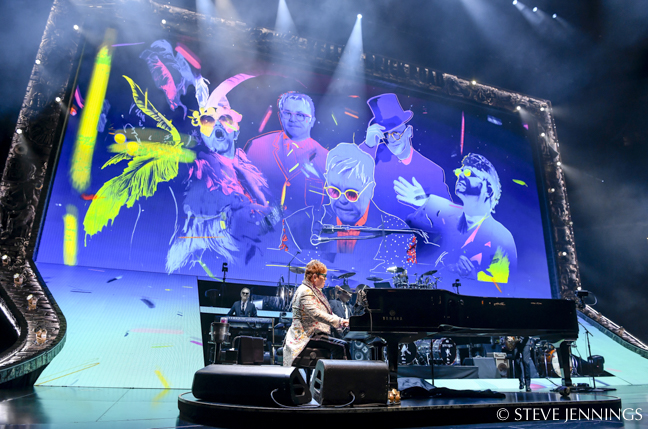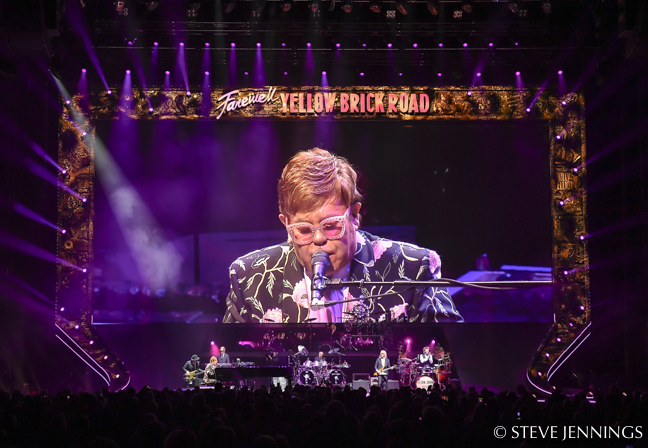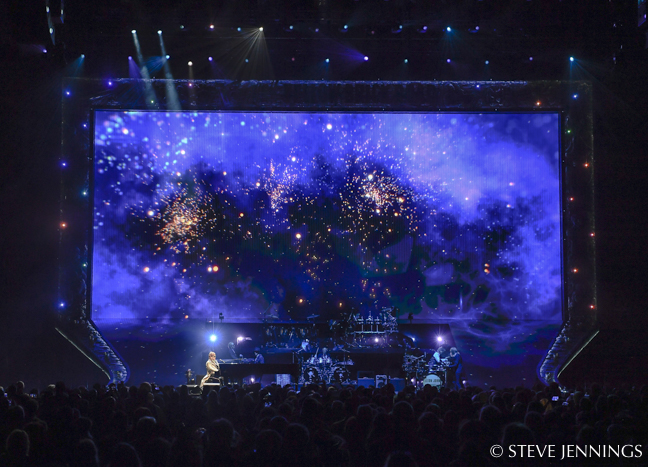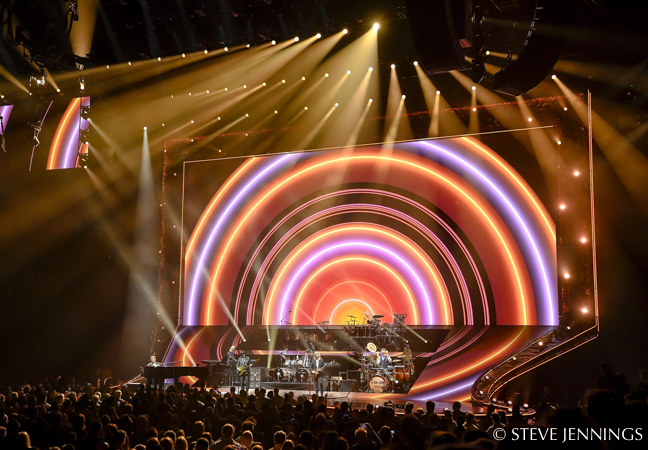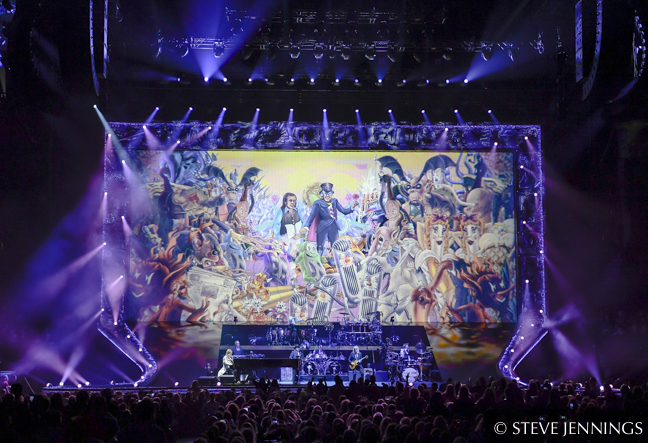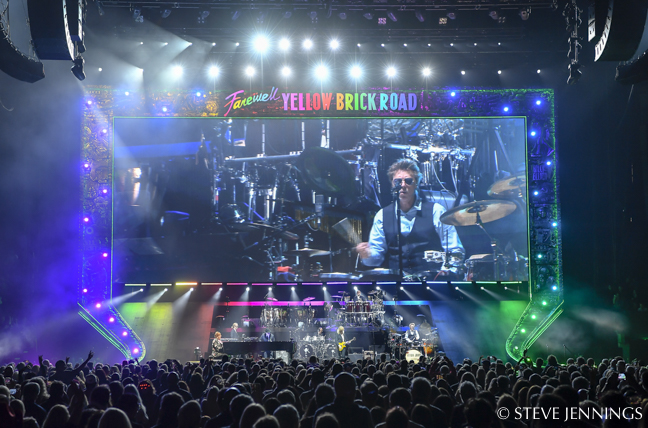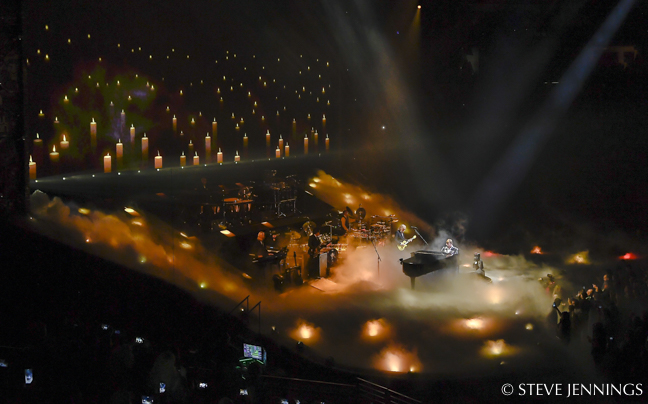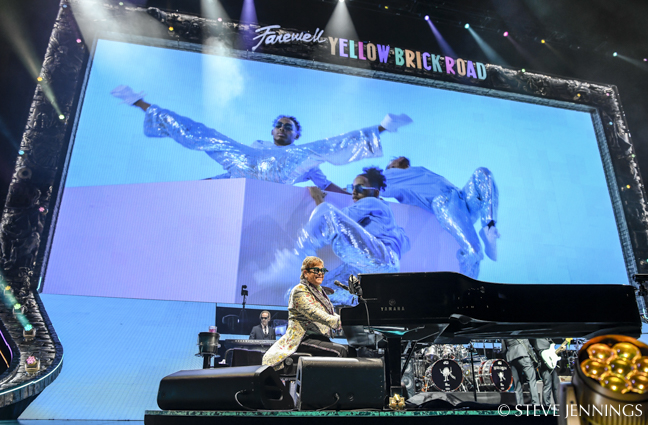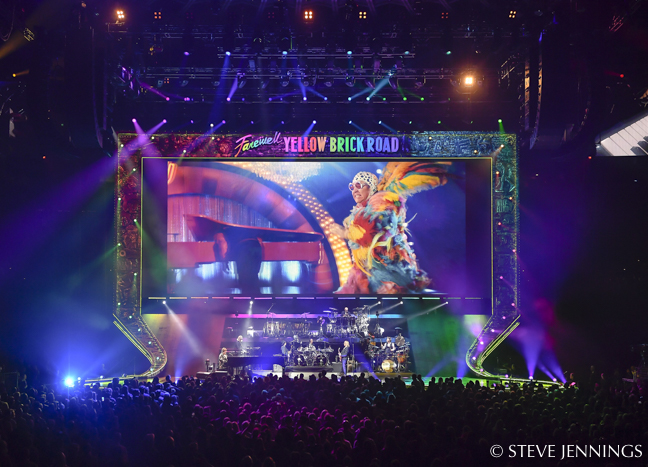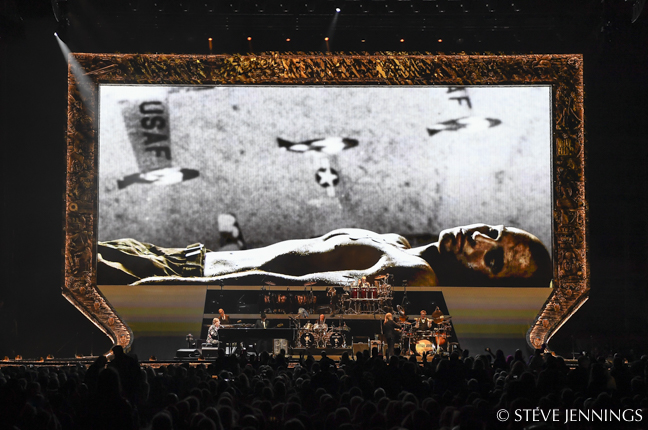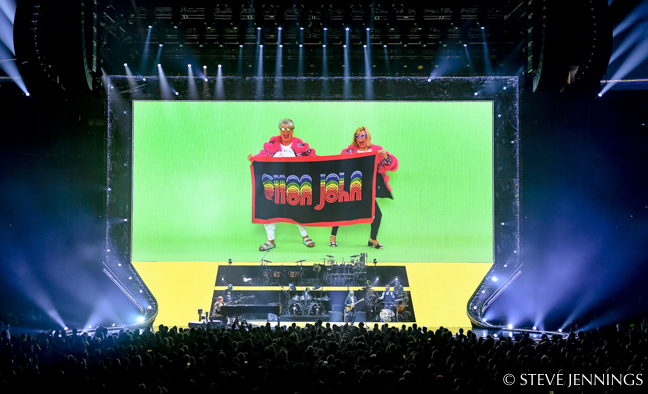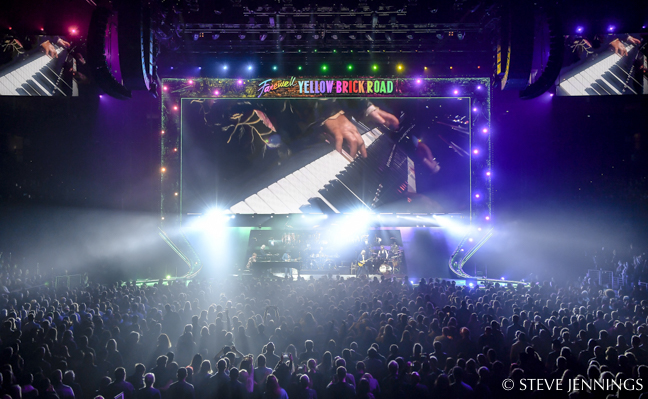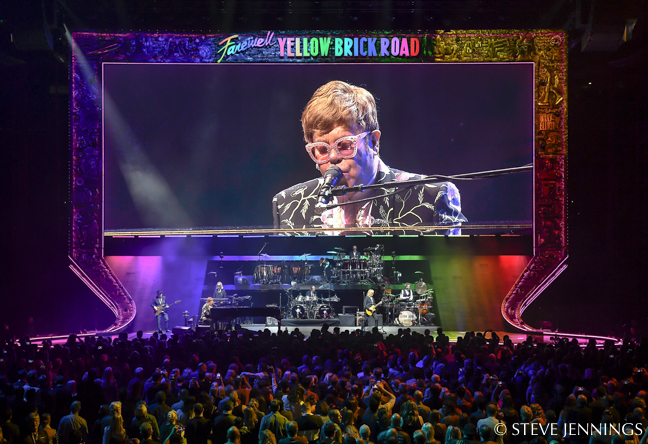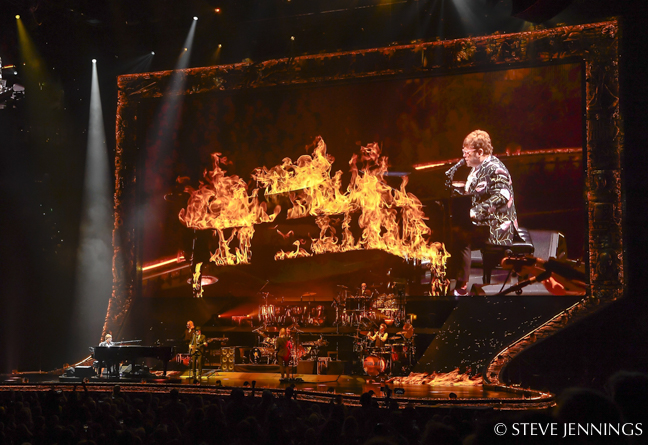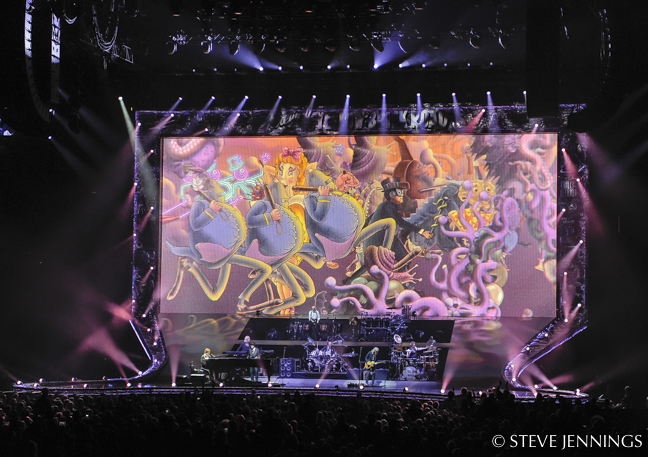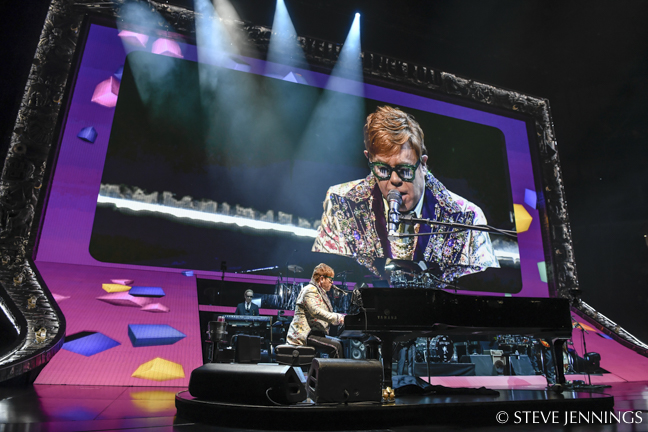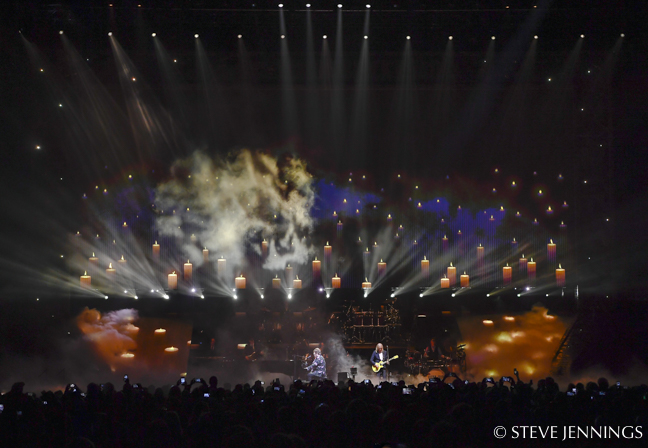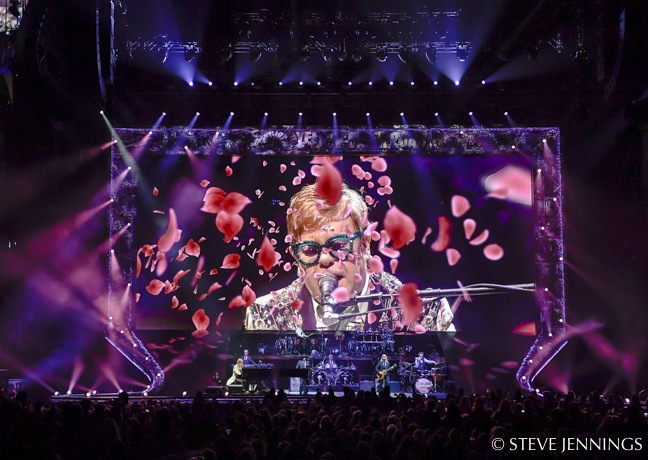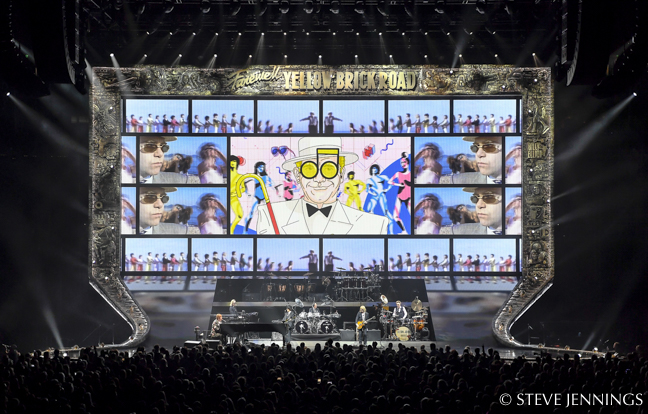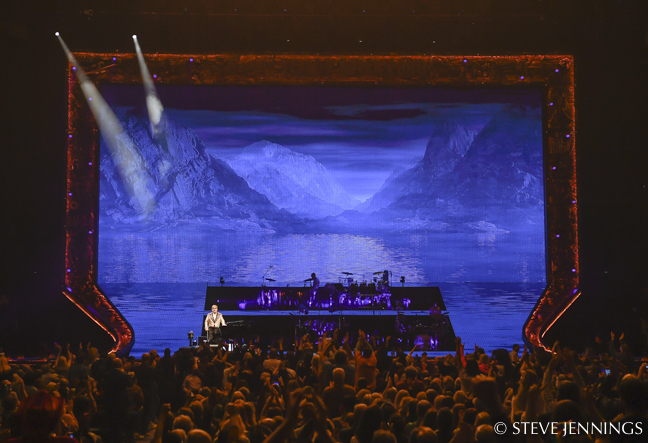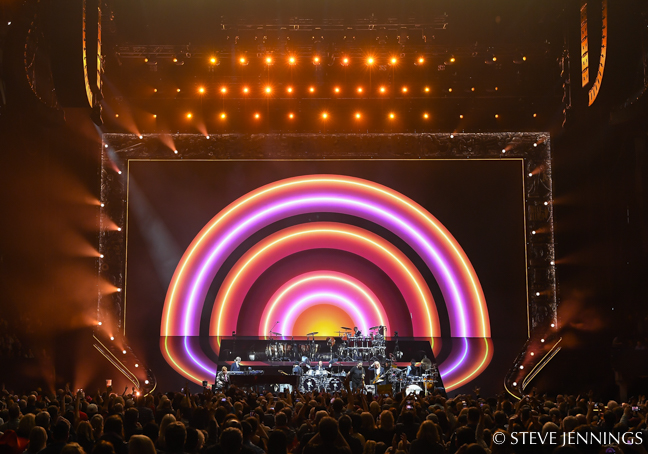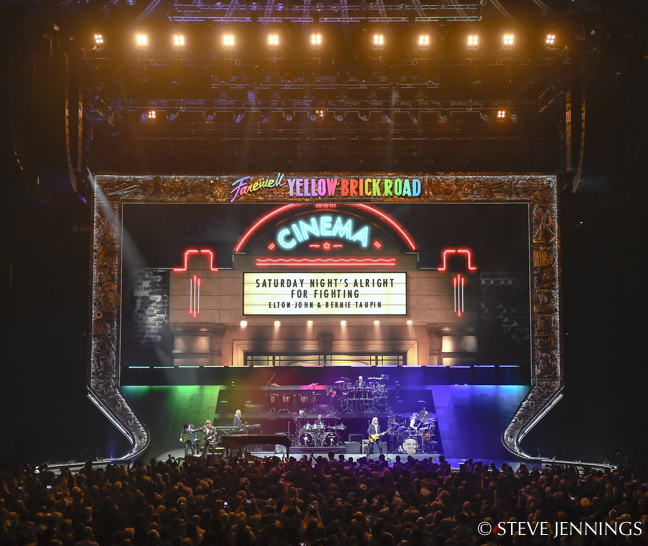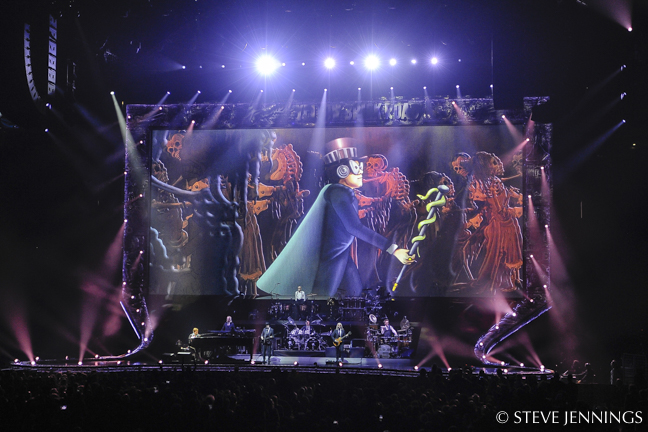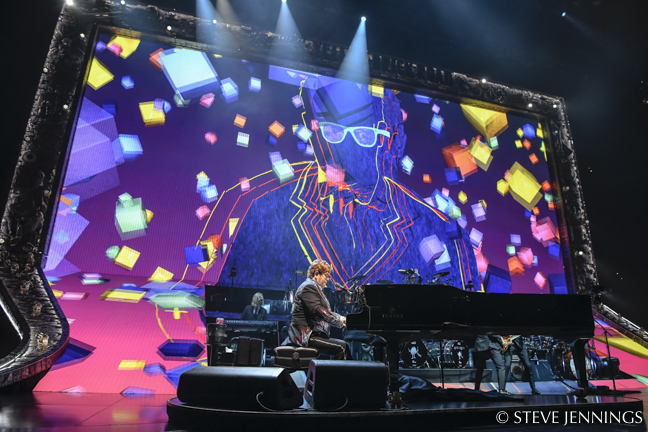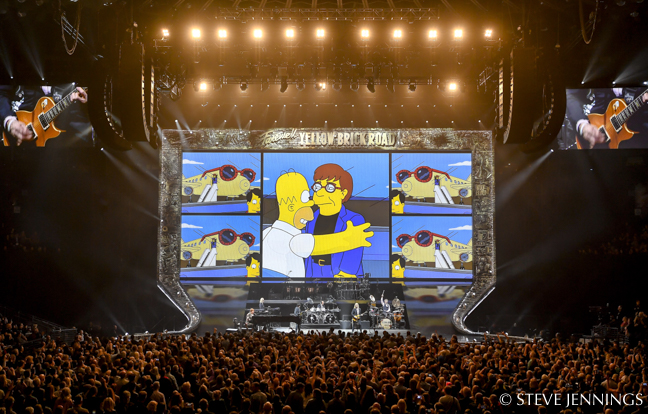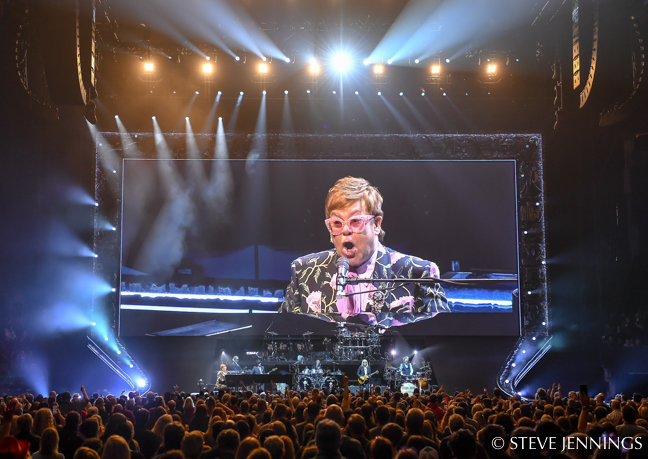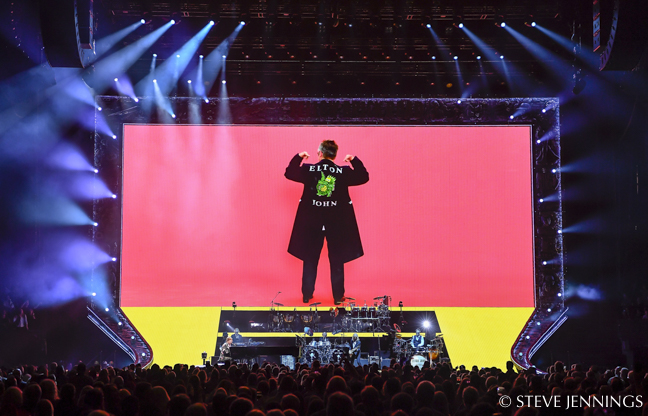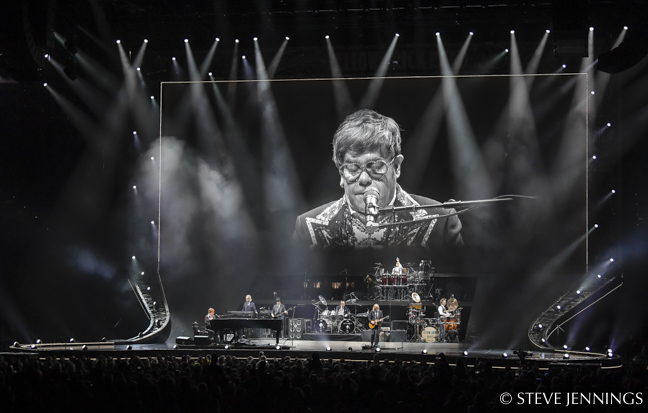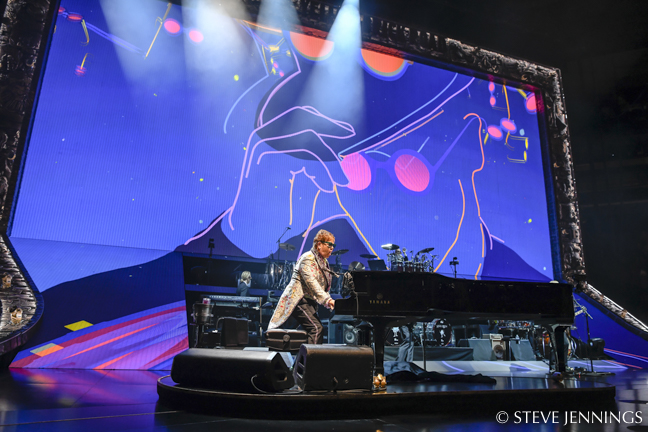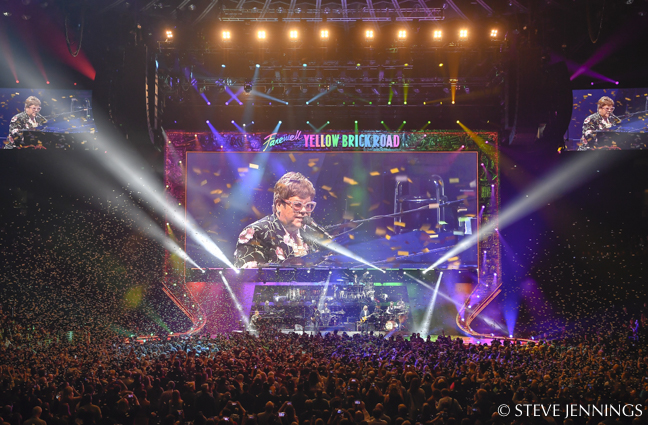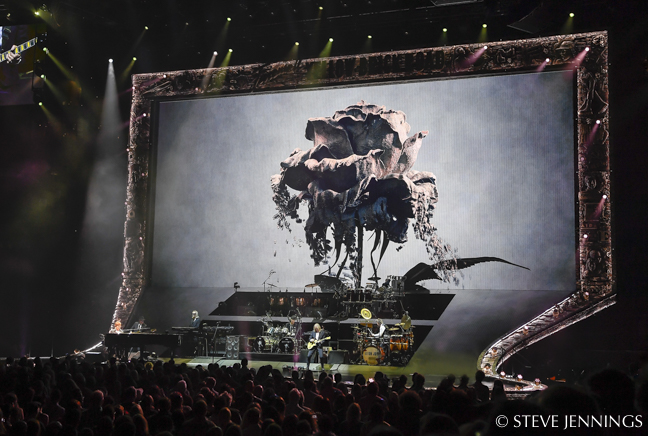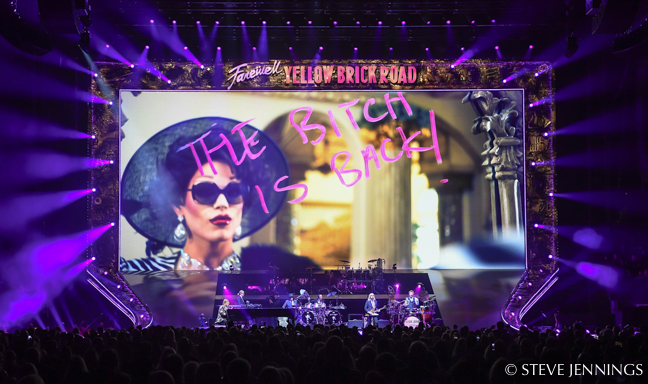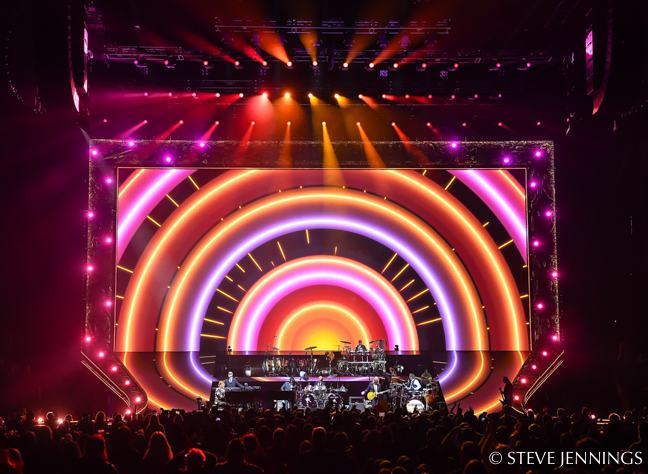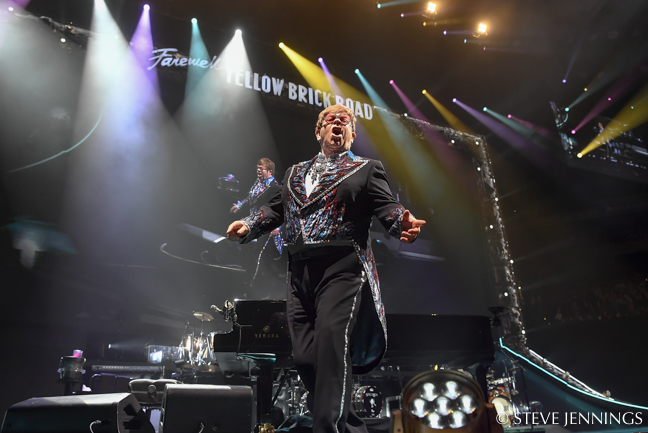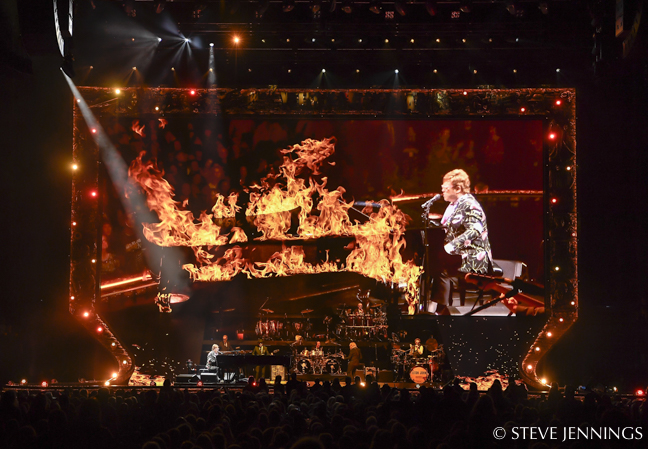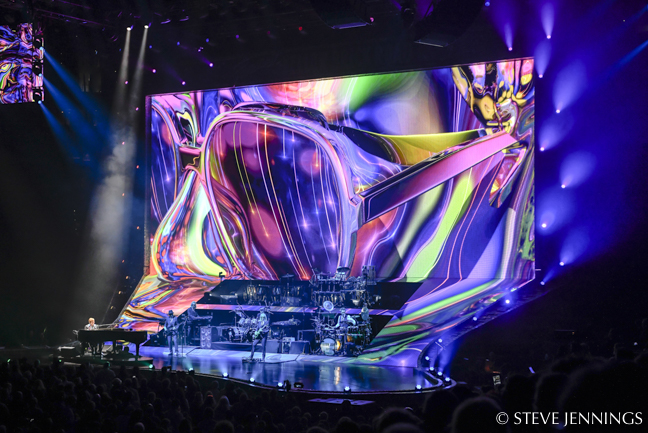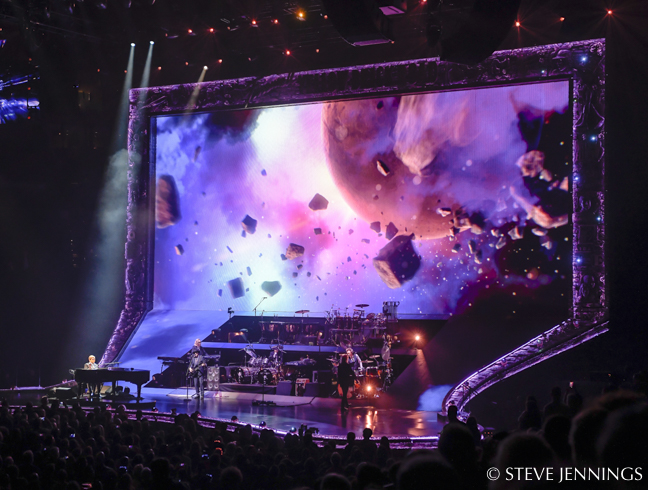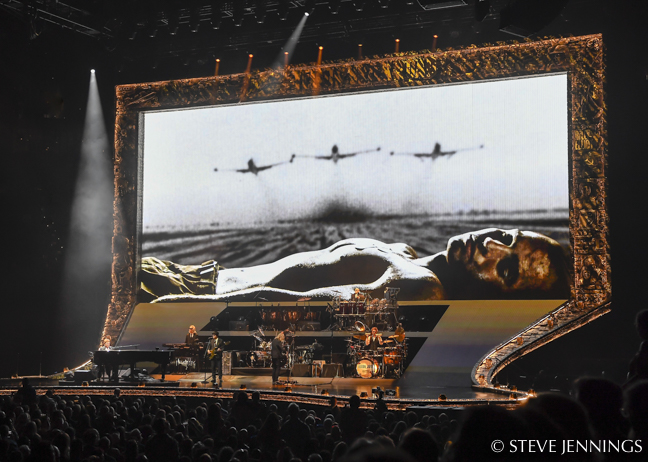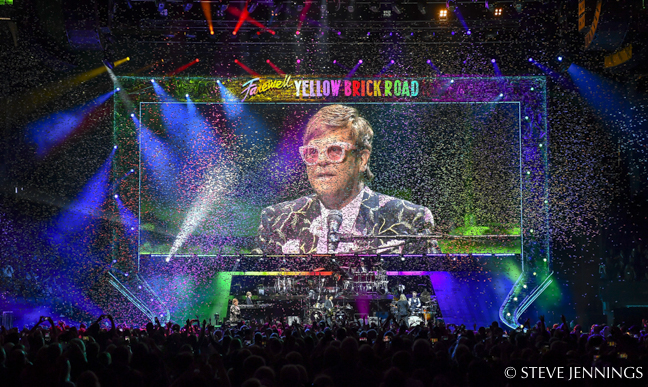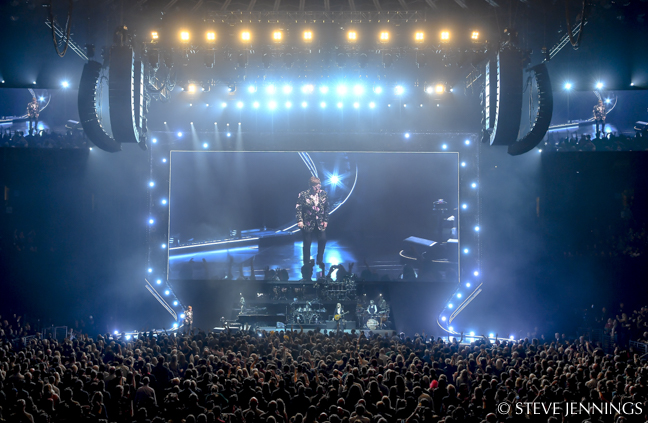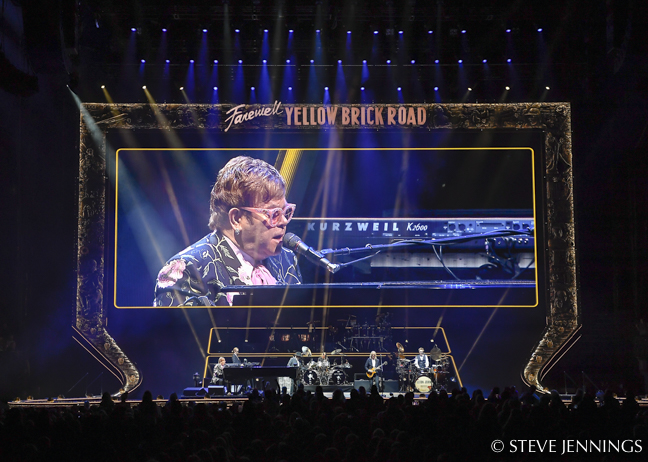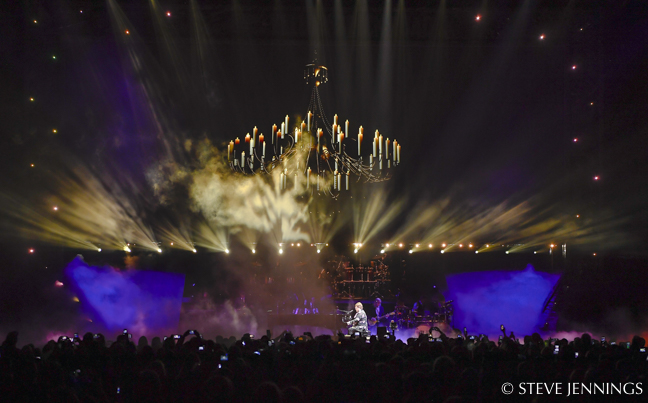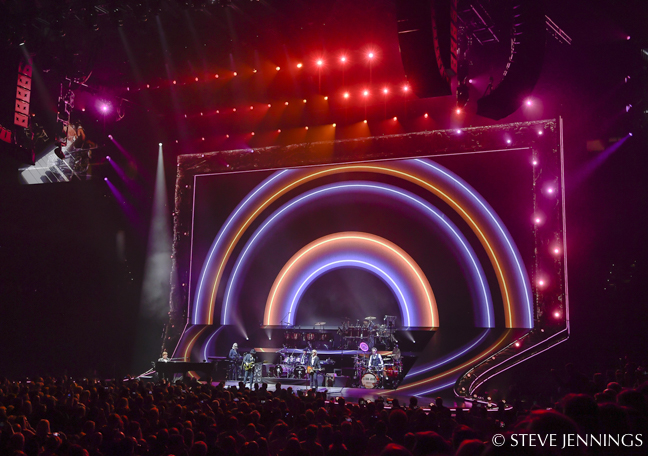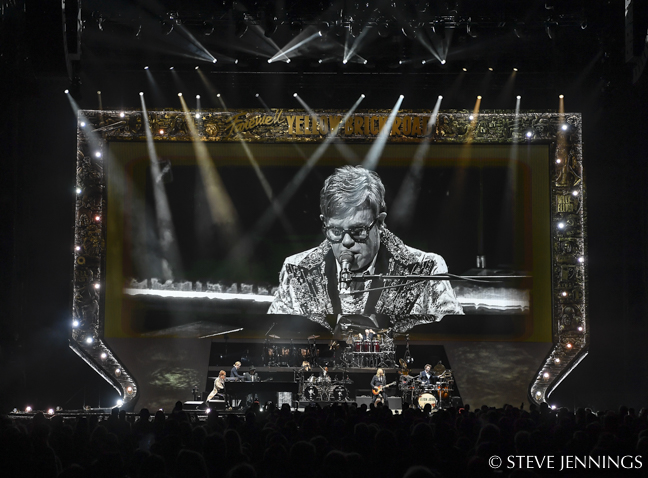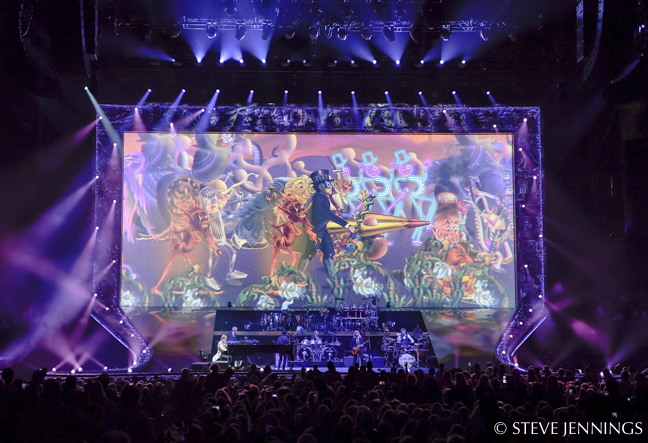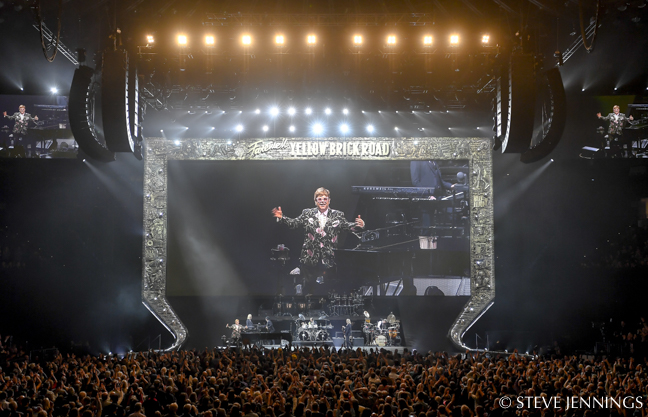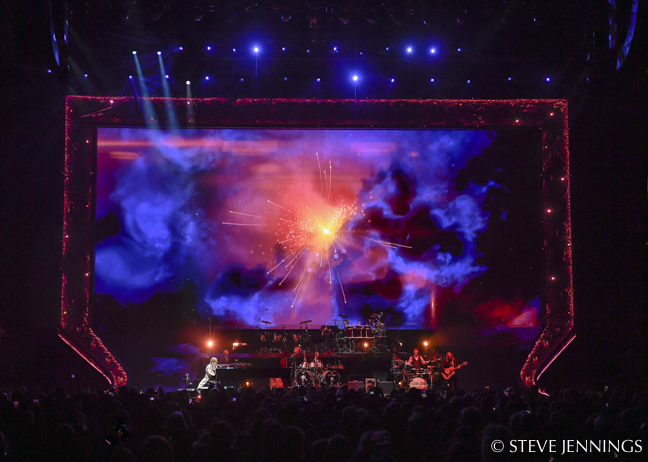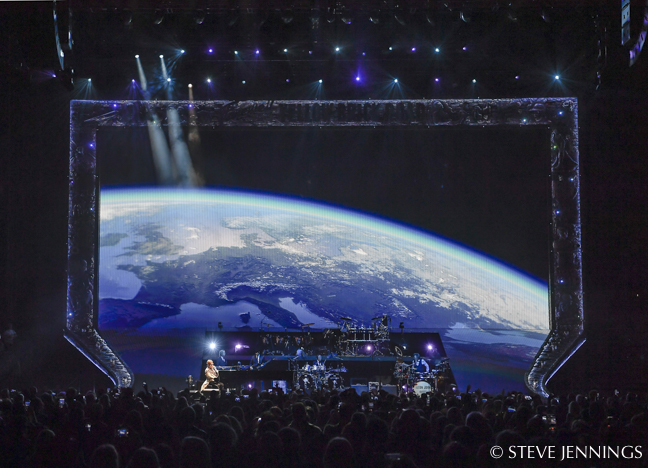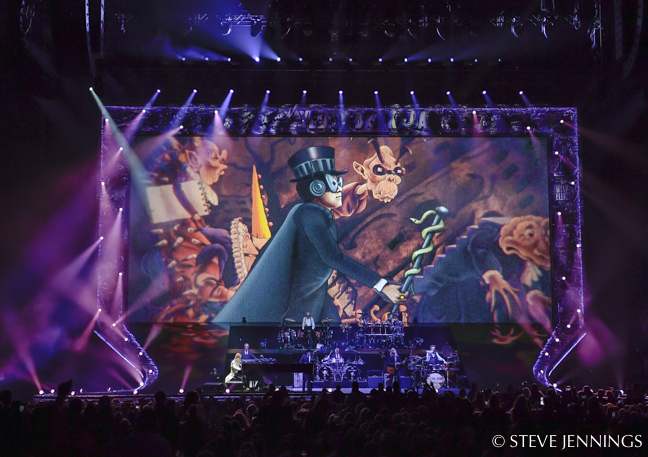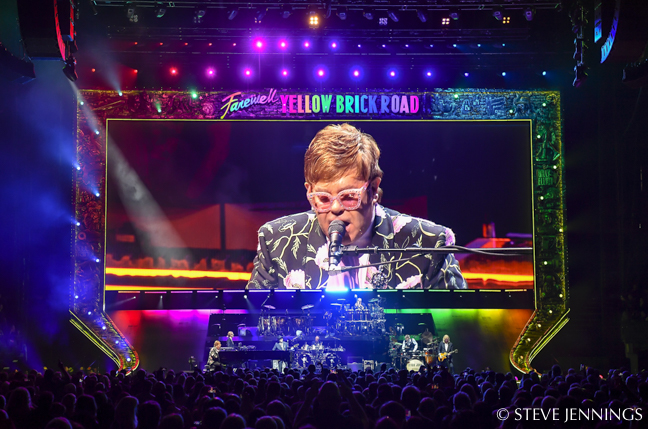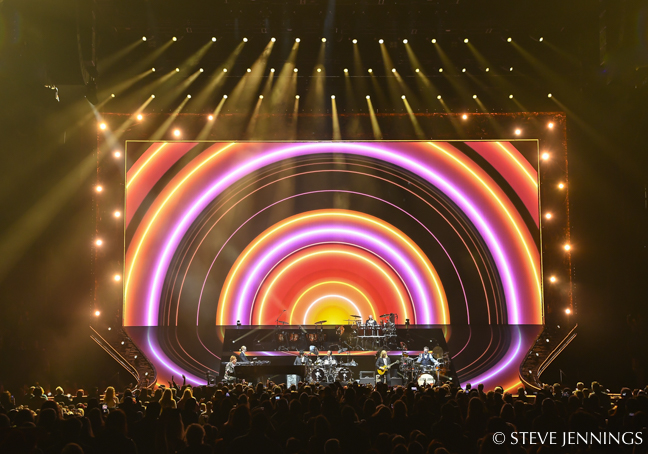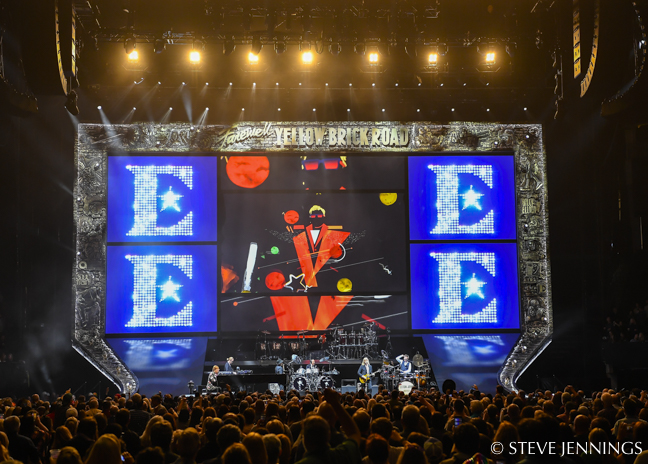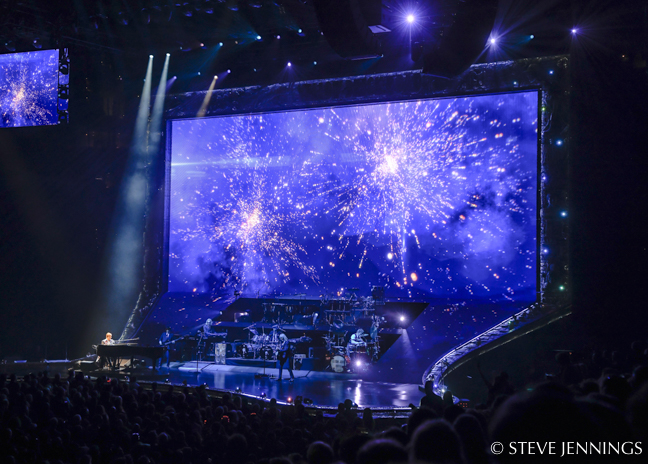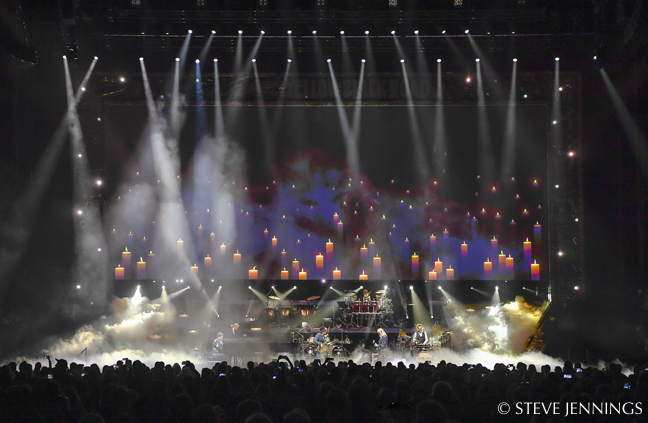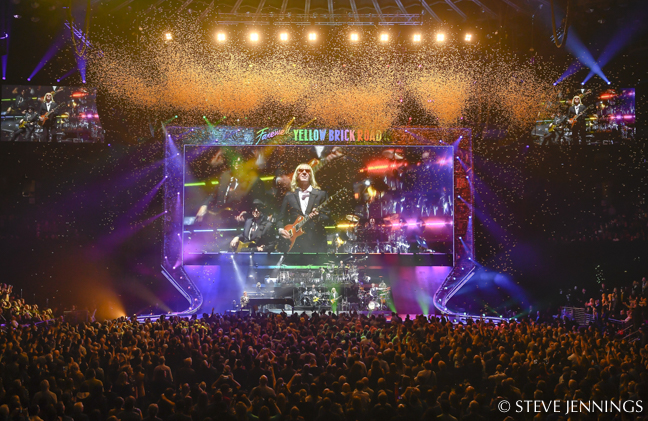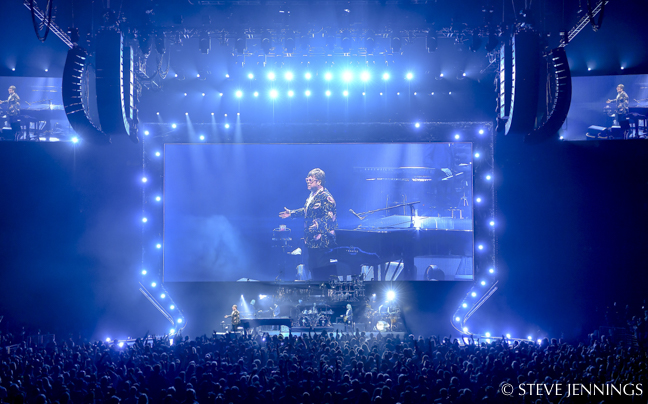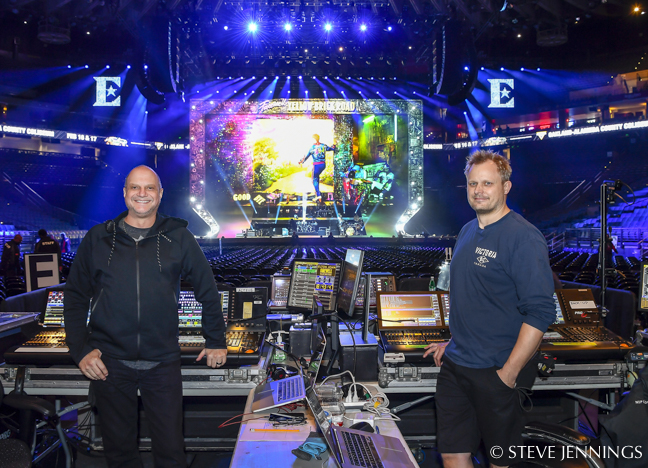
The legendary Elton John is on his “Farewell Yellow Brick Road” tour. With a career spanning 50 years, his tour, which launched Sept. 8, will travel to five continents and perform more than 300 shows. Selling more than 300 million records and numerous accolades to his credit — Grammy Awards, BRIT Awards, an Academy and Tony Award, and even a British knighthood since 1998 — few can match the talent, longevity and popularity attained by this 71-year-old artist. We spoke with key members of the creative team behind his tour, including Patrick Woodroffe (lighting designer), Kevin “Stick” Bye (lighting director), Lars Kristiansen (video programmer/technician), Ray Winkler (set designer from Stufish Entertainment Architects) and Shannon Nickerson (project manager at Tait).
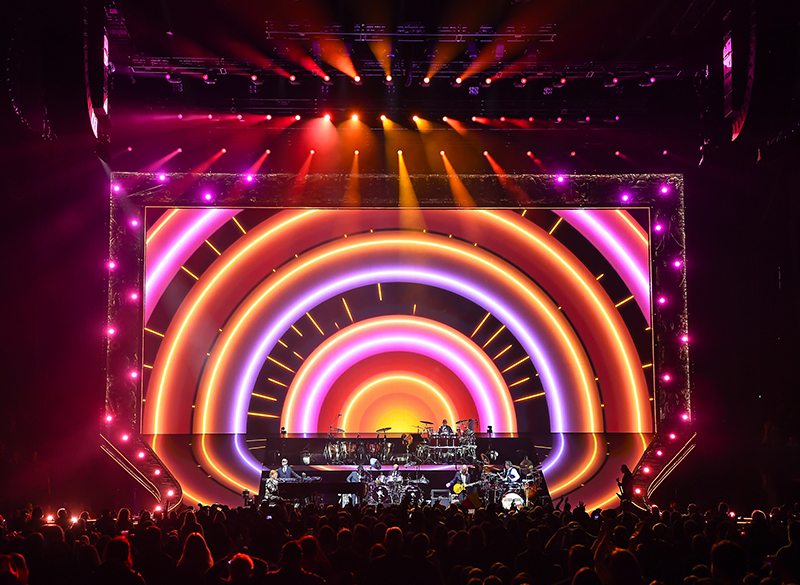
Patrick Woodroffe
Lighting Designer
This tour is Elton’s last hurrah, and he wanted it to be something special that his fans all over the world would remember long after the house lights came up, says longtime lighting designer Patrick Woodroffe. “There was an understanding that, although the production had to be logistically practical, it also had to be spectacular and emotional. The large screen would obviously be the focus of the stage design, as it is used not just for I-Mag but also as a way to tell the story of Elton’s life and career. We gave the screen an elegant gold frame to make it feel bespoke for the show, and this portal became a work of art in itself. The matching of the video and the lighting was key to the way each song had its own distinct look, and Sam Pattinson and I worked with our lighting and video programmers — Eric Marchwinski and Zach Peletz, respectively — to blur the lines between these two elements so that there are times when you don’t know where one begins and the other ends.”
The creative team for the production consisted of Ray Winkler from Stufish, who designed the stage set, Sam Pattinson from Treatment Studio, who created the video content, and Tony King, who is Elton John’s full time creative director. Woodroffe’s role was to light the show but also to tie together the visual elements of I-Mag, video content, lighting, scenic moves and band movement into a cohesive whole, with Elton very much at the heart of it.
“This was with the same team that made the Million Dollar Piano show that ran in Las Vegas for six years so great,” Woodroffe says. “All that spectacle means nothing unless it appears as if it is coming from Elton,” he adds. “The project was led by Elton’s husband, David Furnish, who conceived the overall arc of the show and gave us a clear direction as to how the production should feel. Keith Bradley is the calm center who runs Elton’s touring operation on every level, and he has a team around him who have all been there for many years, so the shorthand among all the departments makes it easy to put together something of such complexity and scale.”
PRG is the lighting supplier for the whole tour, and Woodroffe credits their team for making the lighting production component run smoothly.
“In shows like these, the lighting plot is really just the start of the process, and we are always very keen to get a supplier on board as early as we can,” he says. “In this case, it allowed the PRG team tasked with the project to really understand the thinking behind the design and then to offer suggestions and solutions to make it happen. This works on a technical level, of course, but there are times where their contribution is a creative one too.”
Woodroffe’s associate on the show was WBD’s Terry Cook, and he worked closely with Curry Grant and Eamonn McCullagh of PRG to work out every tiny detail ahead of rehearsals.
“Elton is always a joy to work with and is the only artist I know who gives us complete control in the lighting, video and set design,” Woodroffe concludes. “It means that as we conceive and create the visual effects for the show, we never have to second-guess what anyone else might think and, of course, that gives the team huge creative license. The only boundaries we have to work with are our own collective imagination, and that’s a wonderful way to work. It’s an enormous gift we are given by Elton, and it make the whole exercise pain-free!”
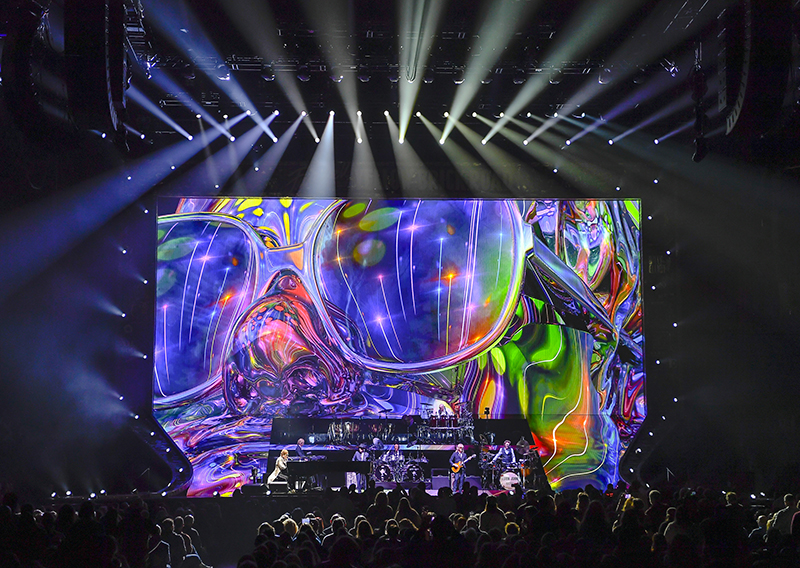
Kevin “Stick” Bye
Lighting Director
Lighting director Kevin “Stick” Bye first started directing Elton on his solo shows back in 1999, so this marks the 20th year he’s been on the road with this artist. Being an old Vari-
Lite guy, Bye was originally manning an Artisan console, then a Virtuoso, moved on to a grandMA1 and currently runs the show on a grandMA2. “Of course, when I first started, I was dealing only with the lighting of the show. Now, as with the rest of the industry, I’m looking after the cueing of lighting and video aspects. Keeping up with emerging technology is a never-ending learning process.
“Patrick (Woodroffe) and Terry (Cook) start with the overview of the design, then Terry and I will have a conversation regarding any additions or moving light positions (based on my experience with the band). This will be the third collaboration I’ve had with Patrick on this show, so there is no ‘getting to know you’ phase. He has a clear direction on what he wants to see overall, then Eric Marchwinski and I will detail the cueing and add in any additional manual controlled “bumps” or accents. Eric and I have worked together before, so he’s familiar with my operating style and board layout. He is a crazy-fast programmer and a talented designer in his own right, so he will also add his input.”
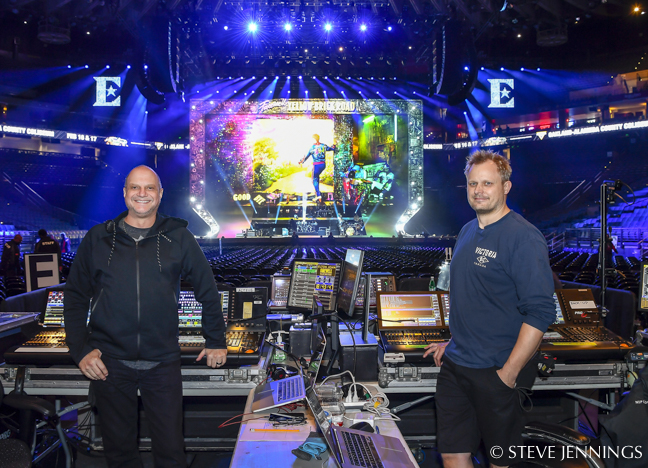
The tour rehearsed at Rock Lititz in August before moving to Allentown, PA for the first show in September. The crew moved rehearsals and programming there, with the first public show a week later. All lighting and video content is programmed into the board as well as song-specific camera inputs, notes Bye.
“There are also song-specific accents and color bumps that I run manually. Additionally, I’ll call the spot cues. Even though the spots are automated, only color is controlled by the console. That way, there is a continuity in the way I call the show. If I get into a show situation like a festival, my show calling doesn’t get rusty! The lighting and video content in the show is tightly programmed and very well-thought-out. That being said, there is no timecode or click tracks, it is a totally live show. I have inhibitive fader control for every type of light fixture as well as the video elements, which allows me to manipulate certain levels in case Elton and the band are playing faster (or slower) than normal.
“We have John Steer, who has been directing the I-Mag video for a number of years,” Bye adds. “He is an expert at sending what we need to the main video element per the creative team’s brief. Our lighting crew chief, Corey Tom, is in high demand so we are very fortunate to have him back for this tour. Lars [Kristiansen] has put up with me for over 15 years, and he is definitely an integral part of this tour! Finally, the Scenius Unicos are the bones of the show, and I’m partial to having a spot fixture-heavy design.
“Well, it’s been a fantastic Elton ride, and a continuous learning experience,” Bye concludes. “I’ve been extremely fortunate to have worked alongside many great designers and technicians and in all sorts of different disciplines — touring shows, both runs of Vegas shows, TV, festivals, corporate events —the list goes on and on. And yes, my touring brethren are my extended family. Even though I’ve been around two decades, I’m still kind of “the new guy” — there are people on this tour that have been around a lot longer than that! I can’t say that I’ve given a lot of thought to this being ‘The Farewell Tour,’ as we are currently scheduled to be out through 2021 and have added shows for next year — so as far as my feelings on this being the last tour, check in with me then!”

Lars Kristiansen
Video Programmer/Technician
Lars Kristiansen’s role on this show is as video programmer and technician, assisting Kevin “Stick” Bye with the lighting on the daily load ins and outs.
“I also look after the content and make sure everything is triggered video wise. All the media is triggered from Stick’s grandMA2 console, and I keep an eye on the network and help reset fixtures, should it be needed during the show. Along with communication with Stick during the show, I am also on headset with our video director John Steer and the video team back stage (Nick Roucco and James Gardener), to help with levels and inform if any issues arise.
“We use disguise media servers and have two gx2 running as slave and understudy while we use a 4×4 as the master. We also run cameras through the system, so we have control of what camera and content is going to what screen. This, too, is controlled from FOH with our grandMA2 console.”
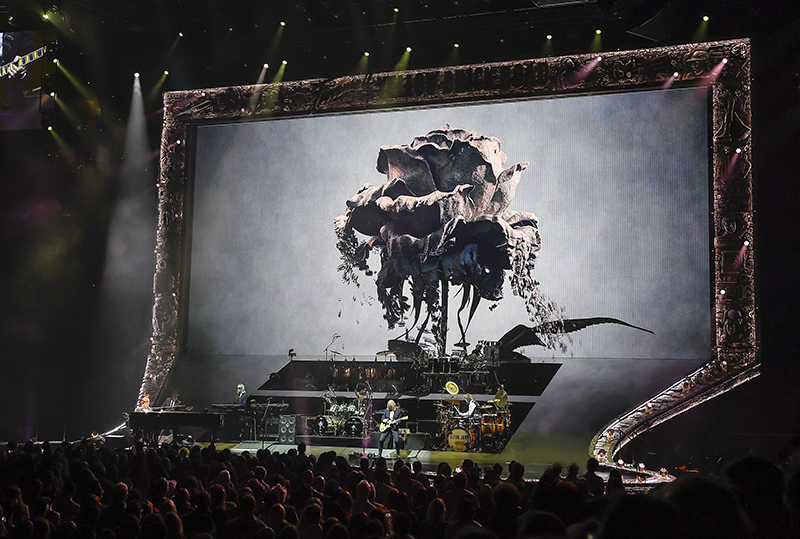
Ray Winkler
Set Design/Stufish
Ray Winkler of Stufish Entertainment Architects says the studio has been very fortunate to have worked with Sir Elton for over 25 years. So when Keith Bradley approached them in early 2015 to be part of the creative team, they were very excited and privileged to be invited back.
“As his Farewell tour, this needed to be a very special show, celebrating Elton’s long and colorful career,” Winkler says. “Creative directors David Furnish and Tony King were focused on bringing together the best creative team for this show. When we first met, the direction for the stage architecture of this show was wide open. We knew that it was an arena show and therefore had to respect certain parameters, but other than that, we were free to explore.
“The idea of a crescent stage and sloping screen was established early as they allowed the audience to get close to Elton and the beautiful video content created by Sam Pattinson’s team,” Winkler says. “The gilded frame that sensuously wraps around the screens and stage gave this design the Elton John hallmark of opulence and quality and became the thread that tied it all together.”
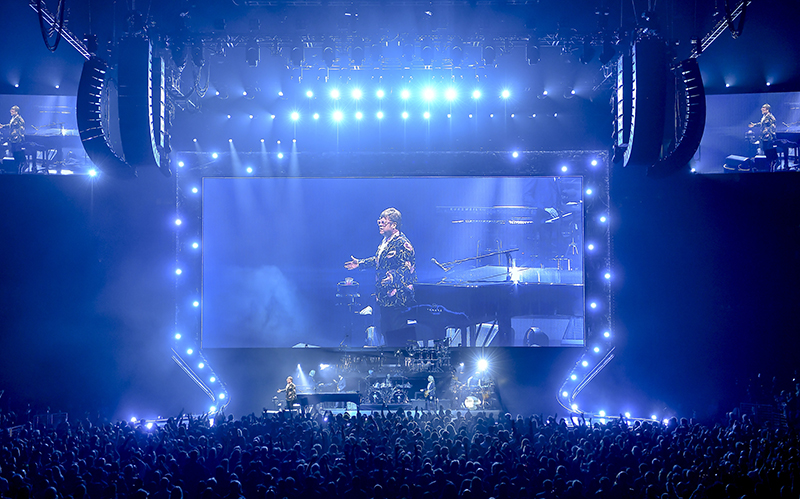
The stage was designed to frame Elton’s performance with the symbolic Yellow Brick Road so that the extensive use of video screens would find a common thread that wove the show and set narrative into a single entity.
“The richly sculpted and gilded portal stood in stark contrast to the flat and clean surfaces of the video screen and allowed for a certain creative tension between the physical and digital world,” Winkler notes.
Jacqueline Pyle did the scenic sculpture for the tour. Winkler says he’s worked with Pyle for many years, and her work has been featured in numerous Stufish designs.
“Jacqui’s eye for detail is superb, and her ability to translate concept sketches into 3D reality is second to none. She worked with us on Elton’s The Million Dollar Piano residency in Las Vegas and was very familiar with the tastes and styles of Elton’s shows, so it was a perfect match to join us on this project. Once the basic concept of a Yellow Brick Portal was established, and the scale and proportions agreed, Jacqui set out to work on the basic layout. Elton and David then handpicked over a dozen of their favorite moments and artifacts for Jacqui to sculpt and integrate into the portal composition.
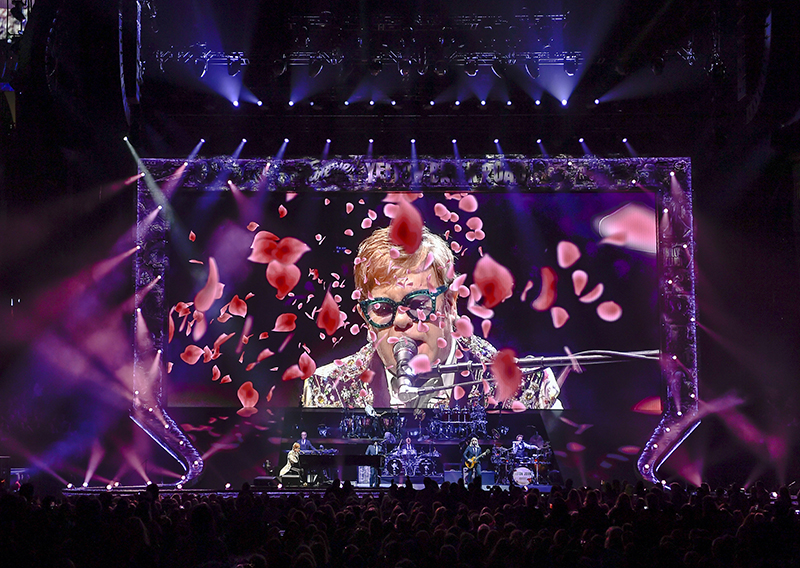
“To make the portal really come alive, we integrated lights into the set while working closely with Patrick Woodroffe and Terry Cook,” Winkler adds. “We carefully placed moving lights and LED strips so that they became an integral part of the design & composition. The set is beautifully fabricated and engineered by Tait so that it can be assembled and taken down safely and quickly every night.
“Stufish’s collaboration’s with Patrick Woodroffe spans over three decades and over the years they have established a creative shorthand and mutual understanding of their respective skills that allows them to create ideas where set and lighting blend into a single entity,” continues Winkler. “Because of this approach, the stage architecture has the strong and clean look it deserves where physical lights and the lighting concept have been thought of early on to give a rich and varied look to the set throughout the show.”
Over the course of the three years Stufish worked on this show, there were many challenges and obstacles to overcome. Ideas were proposed then dropped again, and the stage architecture went through numerous permutations.
“What was consistent on this long journey was the great team that had come together to work on delivering the best show for Elton’s Farewell tour,” Winkler concludes. The passion and experience that was brought to the table was as infectious as it was effective and, looking back on where we ended up, we are all very proud to have been part of this journey.”
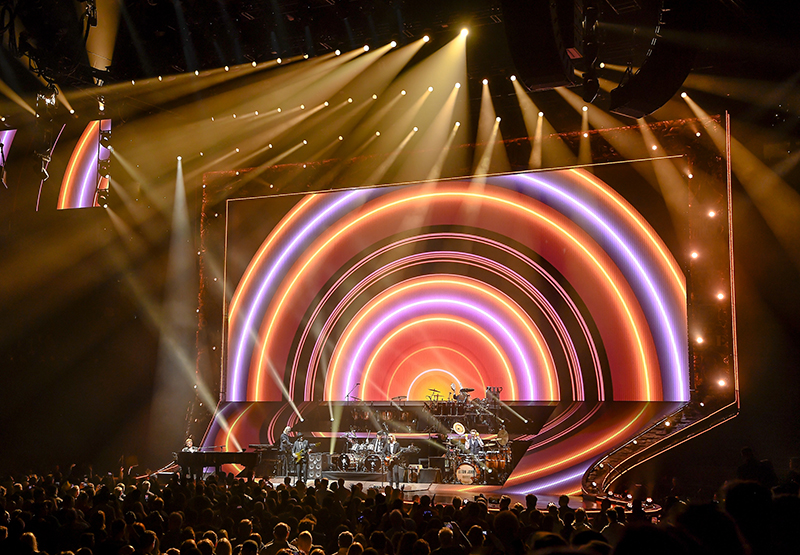
Shannon Nickerson
Project Manager/Tait
Tait was brought into the process a year before the first show, notes Shannon Nickerson, project manager at Tait. The final design developed into the grand piece of art through many conversations. Tait worked with Stufish through the initial design developments as there were different options for the staging.
“As the staging formed into a full vision, we worked with Patrick Woodroffe and Sam Pattinson to integrate lighting and video into the stage, Nickerson says. “Stufish and Jacqui worked with David Furnish on the final layout, and then Tait put together the team to meet the detail and the timeline.”
Jacqueline “Jacqui” Pyle developed 1:6 maquettes (scale models), which were sent to Tait. The Tait team of sculptors and painters built the full-scale artwork using her maquettes along with approved images to get all the details.
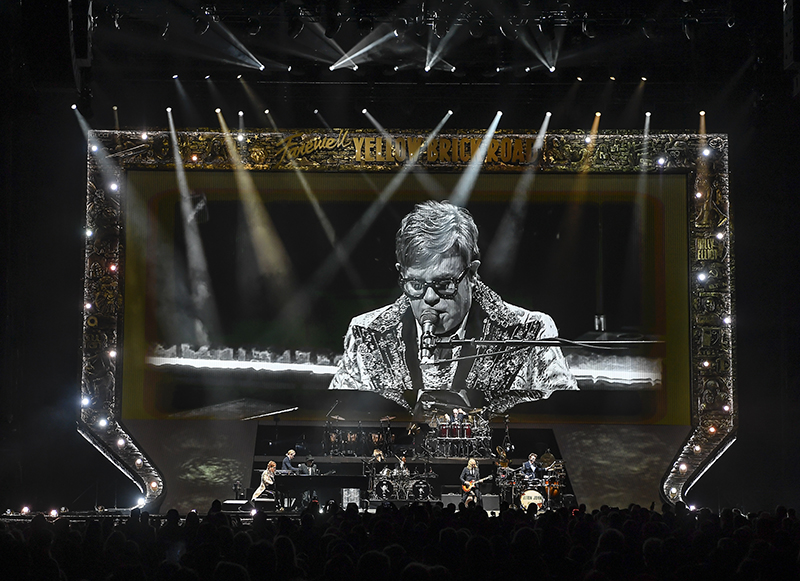
“The process of creating these started with a foam base, which were then built with clay for sculpting,” Nickerson says. “We then made molds of the final art, the pieces range between 15 and 50 pounds. Once you add in the bricks and the structure, each six feet tall piece weighs about 450 pounds.
“The fabrication of the scenic portal needed to be able to withstand the rigors of the road,” Nickerson continues. “To do so, Tait’s scenic team developed a 3D, clay molding and paint sealing process that produces durable scenic pieces that load on/off stage, in/out of carts, and can be exposed to extreme temperatures and handle other production circumstances with little to no maintenance for the duration of the tour.”
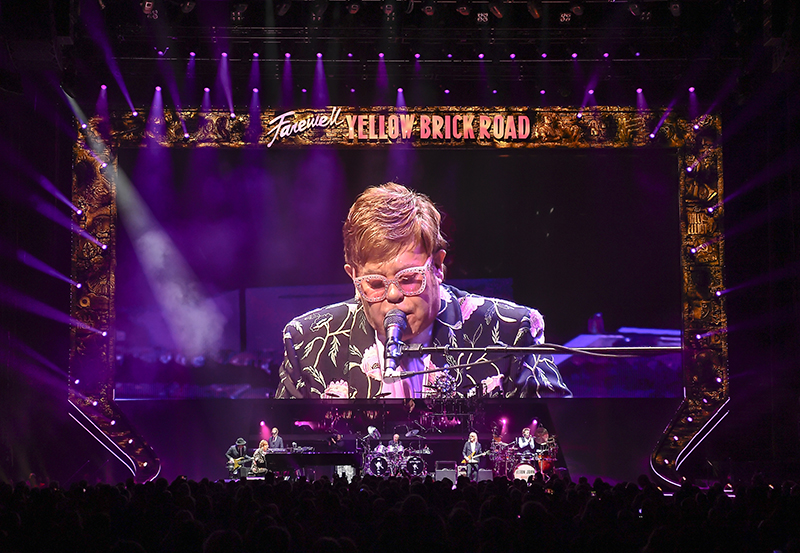
The set features a custom-curved Tait stage equipped with a downstage piano platform that tracks right/left and rotates via Tait Navigator automation platform. “We also control the movement of the LED wall that lifts to reveal lights several times throughout the show,” Nickerson says. “The LED wall runs two inches away from the sculpted bricks. To protect everything, the wall is guided in a track to hold spacing so the wall and ramp appear to be a continuous screen.”
The main stage video screen is made up of two screens. Below the main backdrop video screen is a video screen ramp made from Tait double-deckers with a built-in performance space for Elton John’s band. The LED video ramp is also furnished with a stage left performer lift used after Elton John’s last song, “Goodbye Yellow Brick Road.” Then comes the dramatic moment when the artist makes his grand farewell.
“The main stage video screen relies on 13 Nav hoists to remain stationary when needed, as well as lift up and down four feet to reveal a lighting truss underneath the video screen,” Nickerson says. “The lighting truss is moved by six Nav Hoists so that, at various times throughout the show, the truss is seen peeking out from under the main stage video screen just above the video screen ramp. This allows Elton to make a smooth farewell, 15 feet up in the air, where the video closes behind him.”

Elton John “Farewell Yellow Brick Road” Tour
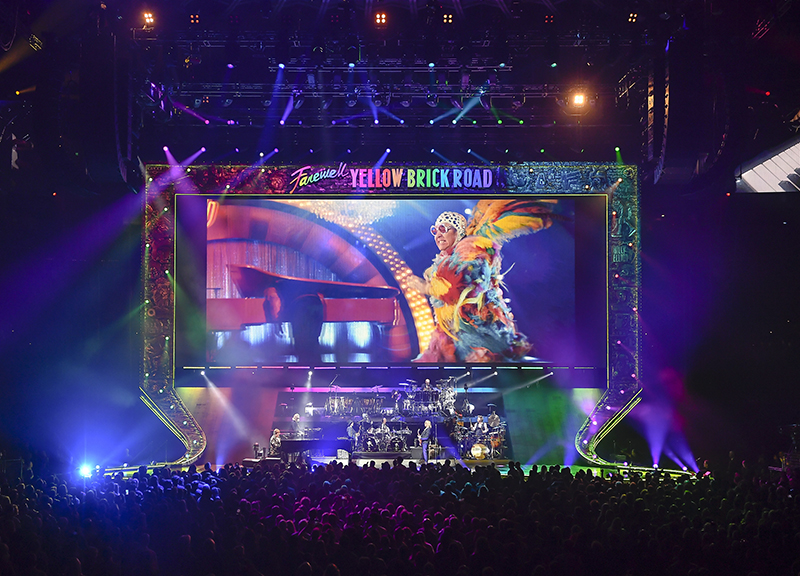
Crew
- Creative Directors: David Furnish, Tony King, Sam Pattinson
- Tour Director: Keith Bradley
- Tour Manager: DC Parmet
- Lighting Design: Patrick Woodroffe/Woodroffe Bassett Design
- Associate Lighting Design: Terry Cook
- Lighting Director: Kevin “Stick” Bye
- Lighting Programmer: Eric Marchwinski
- Lighting Co: PRG
- Lighting Crew Chief: Corey Tom
- Lighting Techs: Mike Rinehart, Kevin Hartrum, Andy Horn, Mike Rothwell
- Lighting/LED Tech: Francis Calabrese
- Lighting/Ground Control Tech: Scott Amiro
- Dimmer Tech: James “JT” Thom
- Video Co: Solotech
- Video Production & Content Co: Treatment Studio
- Treatment Studio Team: Sam Pattinson, Lizzie Pocock, Helen Campbell, Matthew Sanger
- Video Programmer/Media Server Tech: Lars Kristiansen
- Video Programmer: Zach Peletz
- Video Director: John Steer
- Video Techs: Nick Roucco, James Gardener
- Set Design: Stufish Entertainment Architects (Ray Winkler)
- Stage Construction & Automation: Tait (James Fairorth, Brian Levine, Shannon Nickerson, Brock Mearig)
- 2nd Automation: Mike Rothwell
- Scene Sculpture: Jacqueline Pyle
- UK Design Associate: Miriam Evans
- Production Assistant: Sammy-Jo Lizotte (Europe)
- Band Road Manager: Jin-Joo Maddy
- Stage Manager: Dennis McManus, Richard Bagwell
- Riggers: Mike Gomez (Production), Hunter Gomez (Ground)
- Carpenters: Ryan Floyd (Head), Lennie Watson, Ron Czajkowski, Tim “Squid” Finncannon, Kevin “Mo” Hale
- Security: J. David Olsen
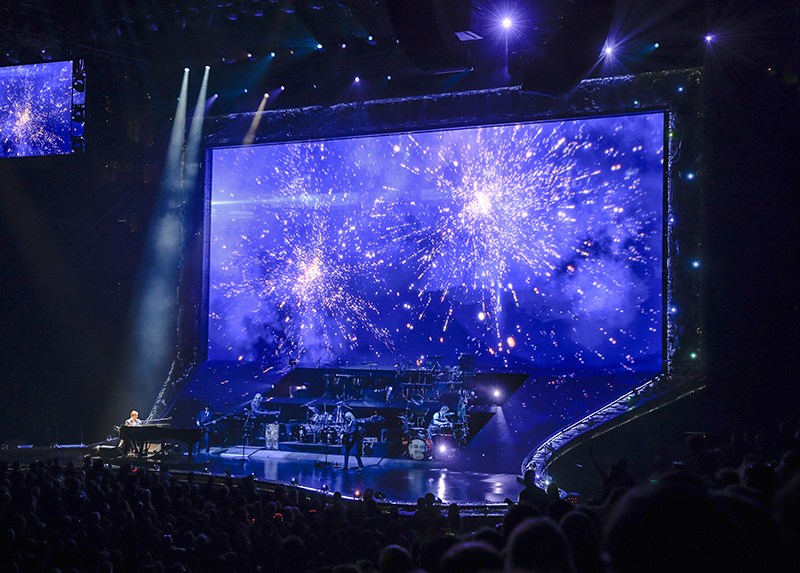
Gear
Lighting:
- 2 grandMA consoles
- 78 Claypaky Scenius Unicos
- 15 Claypaky Mythos
- 38 PRG Bad Boy Spot CMY’s
- 12 PRG Best Boy Spots
- 18 GLP impression X4 Bar 20’s
- 38 4-Lite square DWE moles
- 4 Bad Boy Ground Control Followspots
Video/LED (4x surfaces)
- 1 Upstage Wall & Rake (2790 x 2442 pixels)
- 2 I-Mag screens SL/SR (1056 x 594 pixels)
More Elton John “Farewell Yellow Brick Road” tour photos by Steve Jennings:
